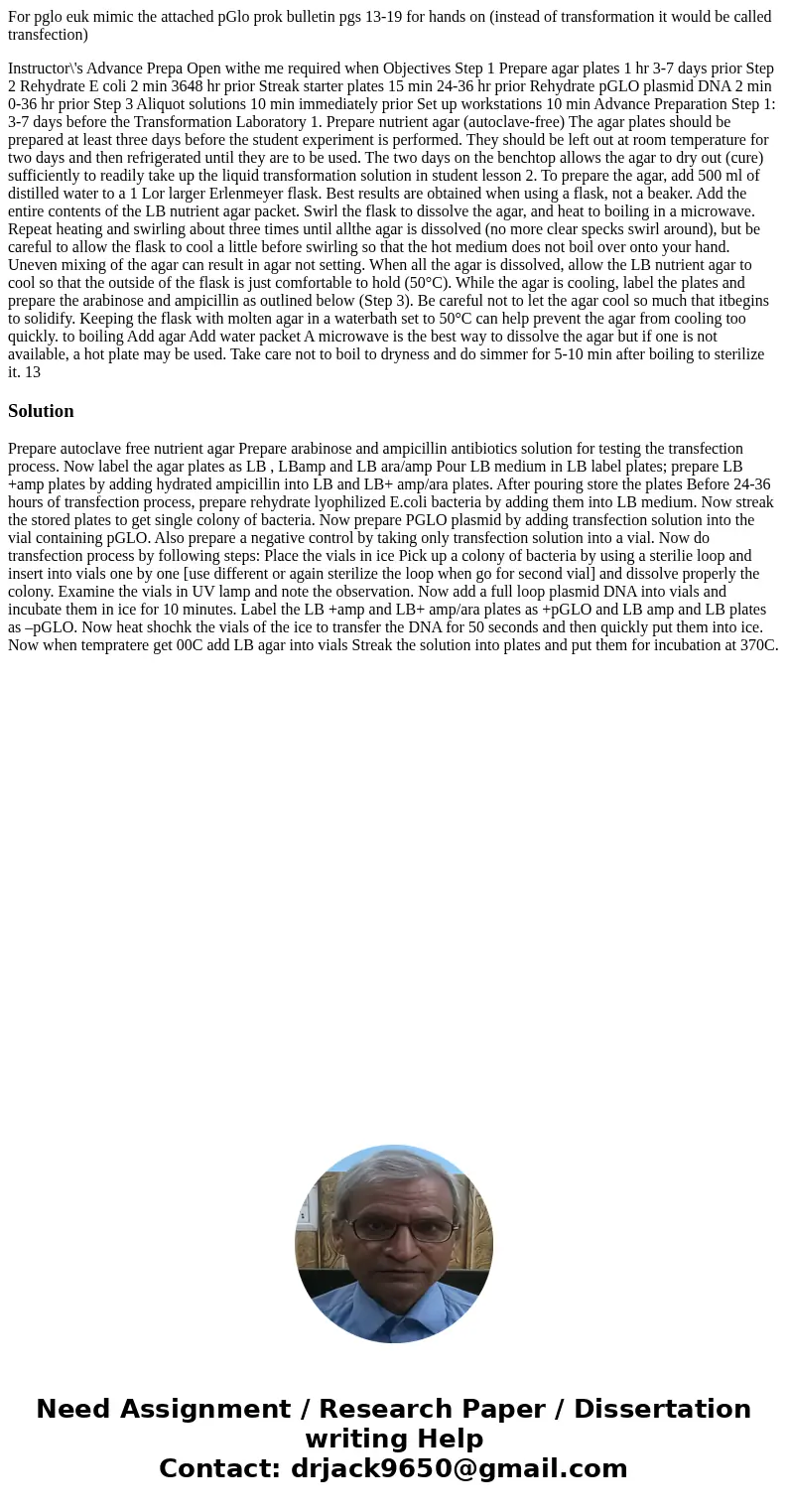For pglo euk mimic the attached pGlo prok bulletin pgs 1319
For pglo euk mimic the attached pGlo prok bulletin pgs 13-19 for hands on (instead of transformation it would be called transfection)
Instructor\'s Advance Prepa Open withe me required when Objectives Step 1 Prepare agar plates 1 hr 3-7 days prior Step 2 Rehydrate E coli 2 min 3648 hr prior Streak starter plates 15 min 24-36 hr prior Rehydrate pGLO plasmid DNA 2 min 0-36 hr prior Step 3 Aliquot solutions 10 min immediately prior Set up workstations 10 min Advance Preparation Step 1: 3-7 days before the Transformation Laboratory 1. Prepare nutrient agar (autoclave-free) The agar plates should be prepared at least three days before the student experiment is performed. They should be left out at room temperature for two days and then refrigerated until they are to be used. The two days on the benchtop allows the agar to dry out (cure) sufficiently to readily take up the liquid transformation solution in student lesson 2. To prepare the agar, add 500 ml of distilled water to a 1 Lor larger Erlenmeyer flask. Best results are obtained when using a flask, not a beaker. Add the entire contents of the LB nutrient agar packet. Swirl the flask to dissolve the agar, and heat to boiling in a microwave. Repeat heating and swirling about three times until allthe agar is dissolved (no more clear specks swirl around), but be careful to allow the flask to cool a little before swirling so that the hot medium does not boil over onto your hand. Uneven mixing of the agar can result in agar not setting. When all the agar is dissolved, allow the LB nutrient agar to cool so that the outside of the flask is just comfortable to hold (50°C). While the agar is cooling, label the plates and prepare the arabinose and ampicillin as outlined below (Step 3). Be careful not to let the agar cool so much that itbegins to solidify. Keeping the flask with molten agar in a waterbath set to 50°C can help prevent the agar from cooling too quickly. to boiling Add agar Add water packet A microwave is the best way to dissolve the agar but if one is not available, a hot plate may be used. Take care not to boil to dryness and do simmer for 5-10 min after boiling to sterilize it. 13Solution
Prepare autoclave free nutrient agar Prepare arabinose and ampicillin antibiotics solution for testing the transfection process. Now label the agar plates as LB , LBamp and LB ara/amp Pour LB medium in LB label plates; prepare LB +amp plates by adding hydrated ampicillin into LB and LB+ amp/ara plates. After pouring store the plates Before 24-36 hours of transfection process, prepare rehydrate lyophilized E.coli bacteria by adding them into LB medium. Now streak the stored plates to get single colony of bacteria. Now prepare PGLO plasmid by adding transfection solution into the vial containing pGLO. Also prepare a negative control by taking only transfection solution into a vial. Now do transfection process by following steps: Place the vials in ice Pick up a colony of bacteria by using a sterilie loop and insert into vials one by one [use different or again sterilize the loop when go for second vial] and dissolve properly the colony. Examine the vials in UV lamp and note the observation. Now add a full loop plasmid DNA into vials and incubate them in ice for 10 minutes. Label the LB +amp and LB+ amp/ara plates as +pGLO and LB amp and LB plates as –pGLO. Now heat shochk the vials of the ice to transfer the DNA for 50 seconds and then quickly put them into ice. Now when tempratere get 00C add LB agar into vials Streak the solution into plates and put them for incubation at 370C.
 Homework Sourse
Homework Sourse